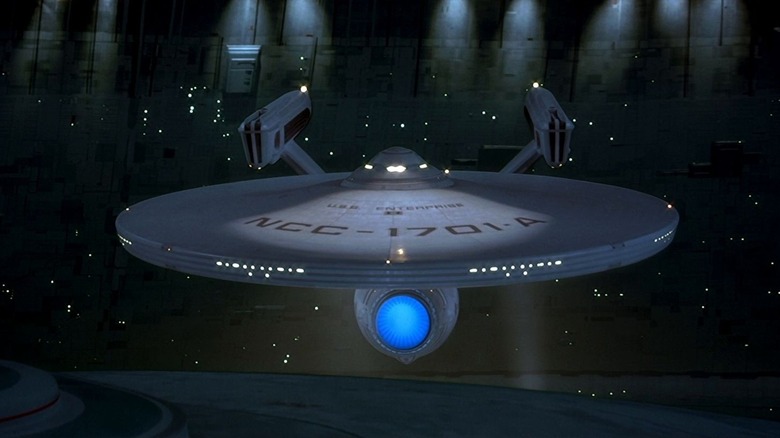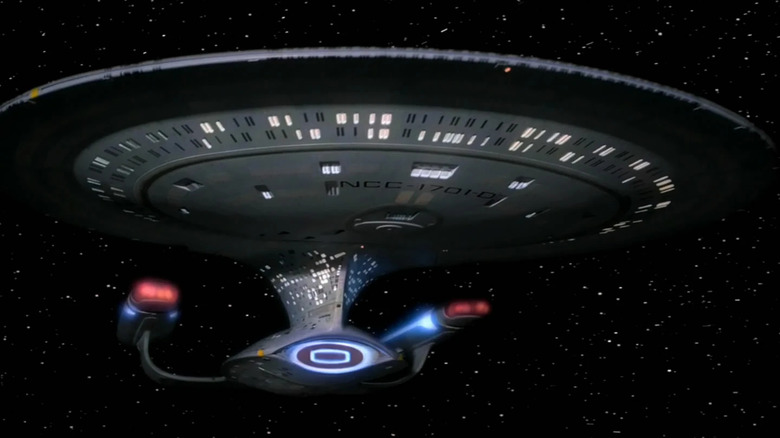We might obtain a fee on purchases comprised of hyperlinks.
As any Trekkie will have the ability to let you know, the registry variety of the united statesS. Enterprise is NCC-1701. In “Star Trek IV: The Voyage Residence,” a brand new Enterprise was constructed with the registry of NCC-1701-A, establishing canonically that starships can preserve the identical identify and designation over a number of generations. Certainly, on “Star Trek: The Subsequent Technology,” the registry quantity was NCC-1701-D, changed by the Enterprise-E in “Star Trek: First Contact” in 1996.
Though it is not explicitly talked about in “Star Trek,” the presence of a registry quantity provides quite a lot of canonical depth to the franchise. Sooner or later, starships will nonetheless be numbered and cataloged like modern-day naval vessels whereas additionally being overseen by a navy-like navy. Starfleet, nonetheless — not like trendy navy our bodies — devotes its strict navy system to exploration and research, not battle or conquest. The registry numbers additionally suggest an unlimited, behind-the-scenes paperwork at work, with unseen pencil-pushers always working onerous to maintain an unlimited navy fleet so as. A corporation as massive as Starfleet would, realistically, require tens of millions of bureaucrats retaining it afloat. The registry numbers give “Star Trek” a practical tinge.
As for the united statesS., that’s a part of a a lot older custom, going again centuries. If Starfleet is to be likened to the trendy navy, then the starships would comply with in the identical nomenclature, and undertake the “U.S.S.” from older instances. Someday within the early seventeenth century, British ships had been gathered because the Royal Navy, and all of the vessels underneath its purview had been designated His Majesty’s Ship or Her Majesty’s Ship. All of the navy’s vessels had been, therefore, given the prefix H.M.S., as within the H.M.S. Pinafore or the H.M.S. Shock.
When the USA began constructing a navy, U.S.S. was used, standing for United States Ship. In “Star Trek,” U.S.S. merely stands for “United Starship.”
The true-life Enterprise
U.S.S. can also be an growth of one other centuries-old nautical abbreviation. Many smaller ships additionally used the prefix S.S. on their hulls, e.g. the S.S. Minnow on “Gilligan’s Island.” S.S. referred to a single-screw steamship, or screw steamer, a generic time period for any steam-powered sea vessel. One may also know concerning the maritime prefixes S.S.C.V. (semi-submersible crane vessel), S.S.S. (sea scout ship), or S.S.V. (particular help vessel). After 1901, most designations had been deserted by then-President Theodore Roosevelt’s administration.
Each nation has its personal related abbreviations, after all, however Starfleet adopted the American system. It’s because, effectively, “Star Trek” is an American present created by an American man. Additionally, inside “Star Trek” canon, Starfleet was based in the USA. Federation headquarters and Starfleet Academy are positioned in San Francisco. Had “Star Trek” been created in Canada, say, the ship is likely to be referred to as the H.M.C.S. Enterprise.
The united statesS. Enterprise on “Star Trek” was named after, effectively, the united statesS. Enterprise. In actual life, the Enterprise was a Yorktown-class plane provider that was in-built 1938 and fought extensively within the Asia-Pacific Struggle. It was considered one of solely three plane carriers to outlive the battle, and was ultimately decommissioned in 1947. When “Star Trek” creator Gene Roddenberry discovered concerning the Enterprise, he was fascinated by its campaigns and determined to make use of its identify on his science-fiction sequence. Initially, Roddenberry needed to call his ship the united statesS. Yorktown, however modified his thoughts. It is a good factor, too. “Yorktown” is restricted to Earth. “Enterprise” is extra common.
By the way, “Yorktown” was ultimately used for different ships and stations in “Star Trek,” together with for the outsize colony seen in “Star Trek Past.”
It does NOT stand for ‘United States Ship’
Plainly Gene Roddenberry as soon as received some jingoistic pushback from studio executives over what U.S.S. ought to stand for. As a result of it was already used on American navel vessels, a few of the higher-ups at NBC assumed that the Enterprise was an American ship and that the long run was dominated by America. “Star Trek,” after all, takes place in a placid future when the Earth has grow to be united and international locations have roughly been eradicated.
In Stephen E. Whitfield’s invaluable sourcebook “The Making of Star Trek,” the creator defined that NBC executives needed the Enterprise to be described as “a great, secure patriotic United States spaceship.” Roddenberry evidently personally fought in opposition to this, feeling that the long run belonged to your entire planet Earth, to not the USA specifically. Whitfield’s e book lastly states categorically that U.S.S. stands for United Starship, which is consistent with the multiculturalism that is at all times been a seminal a part of the franchise.
As for on-screen mentions, within the authentic “Star Trek” pilot “The Cage,” and within the episode “Patterns of Drive” (February 16, 1968), dialogue implied that U.S.S. stood for United Area Ship. That is a type of particulars, nonetheless, that Trekkies are inclined to half-ignore, like they did when Spock (Leonard Nimoy) referred to himself as Vulcanian, not Vulcan. In an official capability, U.S.S. stands for United Starship.
Whether or not or not U.S.S. continues to be used on seafaring vessels within the twenty fourth century, nonetheless, isn’t a element “Star Trek” has ever bothered to deal with.


